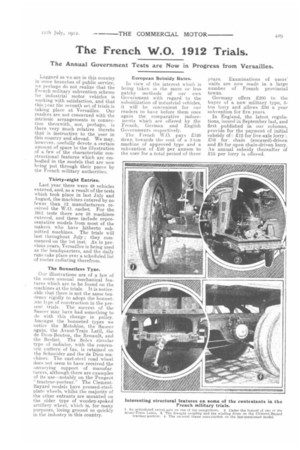The French W.O. 1912 Trials.
Page 13

If you've noticed an error in this article please click here to report it so we can fix it.
The Annual Government Tests are Now in Progress from Versailles.
Laggard as we are in this country in some branches of public service, u e perhaps do not realize that the French military subvention scheme for industrial motor vehicles is working With satisfaction, and that this year the seventh set of trials is taking place at Versailles. Our readers are not concerned with the intrinsic arrangements in connection therewith, nor, perhaps, is there very much relative thereto that is instructive to the user in this country and abroad. We may, however, usefully devote a certain amount of space to the illustration of a few of the characteristic constructional features which are embodied in the models that are now being put through their paces by the French military authorities.
Thirty-eight Entries.
Last year there were 48 vehicles entered, and, as a result of the tests which took place in last July and August, the machines entered by no fewer than 12 manufacturers received the W.O. cachet. For the 1912 tests there are 38 machines entered, and these include representative models from most of the makers who have hitherto submitted machines. The trials will last throughout July ; they commenced on the 1st inst. As in previous years, Versailles is being used as the headquarters, and the daily runs take place over a scheduled list of routes radiating therefrom.
The Bonnetless Type.
Our illustrations are of a few of the more unusual mechanical features which are to be found on the machines at the trials. It is noticeable that there is not the same tendency rigidly to adopt the 'bonnetless type of construction in the present trials. The success of the Saurer may have had something to do with this change in policy. Amongst the bonneted types we notice the Motobloc, the Saure.r again, the Avant-Train Latil, the de Dion-Bouton, the Renault, and the Berliet. The Solex circular type of radiator, with the concentric pattern of fan, is retained on the Schneider and the de Dion machines. The cast-steel road wheel does not seem to have received the unvarying support of manufacturers, although there are examples of its use—notably on the Peugeot " tracteur-porteur." The ClementBayard models have pressed-steelplate wheels, whilst the majority of the other entrants are mounted on the older type of wooden-spoked artillery wheel, which is, for many purposes, losing ground so quickly in the industry in this country. European Subsidy Rates.
hi view of the interest which is being taken in the more or less patchy methods of our own Government with regard to the subsidization of industrial vehicles, it will be convenient for our readers to have before them once again the comparative inducements which are offered by the French, German and English Governments respectively. The French W.O. pays £120 down towards the cost of a 3-ton machine of approved type and a subvention of £40 per annum to the user for a total period of three
years. Examinations of users' units are now made in a large number of French provincial towns.
Germany offers R200 to the buyer of a new military type, 5ton lorry and allows 250 a year subvention for five years.
In England, the latest regulations, issued in September last, and first published in our columns, provide for the payment of initial subsidy of : £12 for live-axle lorry ; £10 for chain (encased)-driven and £8 for open chain-driven lorry. An annual subsidy thereafter of £15 per lorry is offered.






















